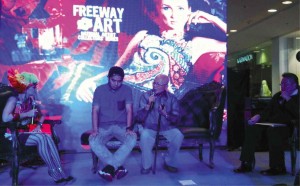The poetry man and the rapper dude
Lines are good for crowd control but what Aristotle Pollisco didn’t realize was that lines are also great equalizers.
Pollisco is the rap artist known as Gloc-9. He was signing autographs at the launch of one of his CDs (he has seven now) when the next man in line turned out to be no less than Bienvenido Lumbera.
Instead of refusing to fall in line, saying he was so-and-so and demanding royal treatment pronto—he is, after all, one of only three living writers who have been conferred the Order of National Artist for Literature, one of three out of 100 million Filipinos—Lumbera waited for his turn.
Such humility floored Gloc-9, who showed his appreciation for the older man’s gesture with a gift of another CD—signed, sealed and delivered to the Lumbera home.
The rapper recalls the incident at the Glorietta 2 mall launch of Freeway’s 2014 National Artist Collectors Series honoring Bienvenido Lumbera—activist, anthologist, critic, columnist, dramatist, educator, librettist, poet and scholar, but not necessarily in that order.
Article continues after this advertisementYou’d repeat the story, too, if you were Gloc-9 because, well, how many hip-hoppers out there can claim to have an 82-year-old national artist for a fan? But then again, how many punk babblers out there have Gloc-9’s social awareness and genius for word craft?
Article continues after this advertisementEven nonfans of rap will remember him as the up-and-comer who, overcome with grief, unashamedly wept on television as he paid tribute to his departed idol, mentor and friend Francis Magalona.
Lumbera’s admiration is something that the much-awarded Gloc-9 has taken care to nurture. Despite a full calendar, he obliged the poet with an interview for an online column that the latter published on bulatlat.com. He graced Tatay Bien’s 80th birthday celebration with two numbers, to which the honoree’s grandkids reportedly rapped along. And today, at this unveiling of the Lumbera-inspired fashion collection, he is doing three songs.
In “Upuan,” said to be Lumbera’s favorite, Gloc-9 rhymes to the vocals of Jeazell Grutas of Zelle. In “Takipsilim,” he engages in wordplay as young talent Lirah Bermudez does the honors

RAP SESSION Gloc-9 performs “Upuan” featuring Jeazell Grutas at the Freeway tribute to Bienvenido Lumbera at Glorietta 1.
on the refrain that originally featured Regine Velasquez-Alcasid. Lastly, and to the delight of the mall crowd, Gloc-9 renders his hit single “Sirena.”
The entertainment is followed onstage by a conversation among celebrity host Tessa Prieto-Valdes, Philippine School for the Arts director Vim Nadera, who was a student of Lumbera’s, Gloc-9 and the man of the hour himself.
Rap fan
Lumbera says he is a rap fan because he is interested in popular culture, more so in Filipino pop that talks of societal ills, citing Gloc-9’s “Upuan” as an example for its “cogent criticism” of the disparities between the lives of the poor and the rich.
“Narinig ko yung kanta, naantig ang aking kalooban na may isang popular artist na tumalakay sa mga ganyang problema (I heard the song and I was moved that a popular artist discussed such problems),” he says.
“Upuan,” which is fast becoming an anthem, is one of two Gloc-9 compositions that the Department of Education has included in the new K to 12 curriculum for the public elementary and secondary schools’ Pilipino subject. The other one is “Hari ng Tondo,” a gangsta rap in the literal sense, reflecting as it does the culture of violence legendary in some streets of Manila.
In this regard, perhaps, the rap artist is even more endeared to Lumbera, who has been a teacher for most of his life and has been helping promote the teaching of the Filipino language, literature and life at Ateneo de Manila University, De La Salle University and the University of the Philippines Diliman (where he remains a professor emeritus).
Having found his way to the classroom via rap—a genre where spoken words are layered over the beat and vibe of a pop tune—Gloc-9 now complements Tatay Bien’s role in learning, although the latter is doing it through scholarly works, most notably “Philippine Literature: A History and Anthology,” “Filipinos Writing: Philippine Literature from the Regions” and “Paano Magbasa ng Panitikang Pilipino: Mga Babasahing Pangkolehiyo.”
Advocacies
If Lumbera created and mobilized organizations advocating for freedom and human rights in the time of martial law, resulting in his arrest and detention, his flip side is Gloc-9 who, as the National Peace Ambassador for the peace process in Mindanao, gives concerts in war zones and areas of conflict.
Gloc-9 has also supported a less dangerous but no less important advocacy through the rap “Katulad ng Iba,” which he composed for an antibullying campaign and recorded with Zia Quizon last year.
Coincidentally, the rap artist’s albums are titled “Diploma,” “Matrikula” and “Talumpati”—all associated with education. The title of his most recent album, “Liham at Lihim,” is a flip-flopping of words that recalls to mind Lumbera’s book of poetry, “Likhang Dila, Likhang Diwa.”
Gloc-9 plans to rework his rap lyrics into a book of poems. With rap, it is hard for most listeners to follow the words because, he says, the melody can be distracting.
Most of his material, he says, comes from the stories he has lived and those he saw and heard while tending his mother’s small store in Rizal province. “Usisero talaga ako (I’m a real busybody),” he says.
His gritty narratives may be about social problems but the young can definitely relate because of the street rhyming and the words that are never abstract.
Lumbera is no stranger to music himself. He wrote the librettos for the well-received musicals “Tales of the Manuvu,” “Nasa Puso ang Amerika,” “Bayani,” “Noli Me Tangere” and “Hibik at Himagsik ni Victoria Laktaw.”
It is Lumbera’s poetry, however, that is represented in the current Freeway collection.
“I had no idea of the kind of work they do,” he says. “They showed me some samples and I liked the concept of wearable art.” Much of his work is in Filipino, he says, but Freeway used the English translations.
Before the launch program wraps up, Valdes suggests a collaboration between Lumbera and Gloc-9 on the lyrics of a new song.
“I’ll be most flattered,” says the national artist. “Pero hindi kailangan; kayang-kaya niya (But there is no need for it; he does nicely by himself).”
Still, think of the possibilities. Gloc-9 rapping the literature of Bienvenido Lumbera should be something worth falling in line for.
Must read
WHAT works written by Filipinos should every Filipino read? According to National Artist for Literature Bienvenido Lumbera, the must-reads are:
1. Portrait of the Filipino as an Artist by Nick Joaquin
2. Bayang Malaya by Amado V. Hernandez
3. Sa Kuko ng Liwanag by Edgardo M. Reyes
4. My Brother, My Executioner by F. Sionil Jose
5. People in the War by Gilda Cordero-Fernando

